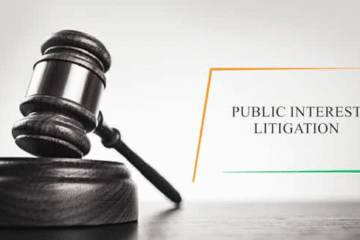
This article is written by Anushka Sinha of Amity University, Noida, an intern under Legal Vidhiya
Abstract
The interplay of constitutional and administrative law forms the cornerstone of modern administrative structures. This article examines the complex relationship between these two branches of law and highlights the balance of power, responsibility, and fairness in administrative decision-making within a constitutional framework. Through landmark cases and principles of natural justice, the article delves into the dynamic interaction between constitutional rights and administrative action, highlighting the judiciary’s critical role in upholding the rule of law and protecting individual liberties.
Keywords
Constitutional law, administrative law, Balance of power, Judicial review, Natural justice
Introduction
Constitutional law and administrative law are two pillars of the legal system that intertwine and interact to form the framework of governance in a country. While constitutional law establishes the basic principles, structure, and rights of a nation, administrative law governs the actions and decisions of administrative bodies and ensures their compliance with constitutional principles. The interplay of constitutional and administrative law forms the cornerstone of modern administrative structures. This article examines the complex relationship between these two branches of law and highlights the balance of power, responsibility, and fairness in administrative decision-making within a constitutional framework. This article delves into a comparative study between constitutional and administrative law, examining their relationship, differences, and significance in modern legal systems.[1]
Understanding Constitutional law
Constitutional law serves as the supreme law of the land, providing the basic framework for governance and defining the relationship between the state and its citizens. It usually includes written documents such as constitutions, charters, and amendments, as well as unwritten principles derived from judicial interpretations and historical practices. Constitutional law establishes the structure of government, defines the powers and functions of various branches, and guarantees fundamental rights and freedoms.
Constitutional law serves as the yardstick against which all other laws, including administrative regulations, are measured. It establishes the boundaries within which governmental authority operates and protects individuals from the arbitrary exercise of power. Key concepts such as separation of powers, federalism, checks and balances, and the rule of law are central to constitutional frameworks around the world.
Examination of Administrative law
Administrative law, on the other hand, focuses on the mechanisms and procedures by which government bodies and agencies operate and make decisions. It manages the activities of administrative offices, regulatory bodies, and other instruments of the state. Administrative law covers a wide range of issues, including rulemaking, adjudication, enforcement, licensing, and government procurement.
One of the primary functions of administrative law is to ensure that administrative actions are lawful, transparent, and accountable. It establishes rules and standards for decision-making processes, procedural fairness, access to information, and judicial review of administrative decisions. Administrative law also addresses issues of delegation of authority, ultra vires suits, administrative discretion, and remedies available to aggrieved parties.[2]
Benchmark: Key areas of Convergence and Divergence
While constitutional law and administrative law share the common goals of promoting good governance, protecting individual rights, and preserving the rule of law, they also exhibit significant differences in scope, focus, and methodology. A comparative examination reveals several key areas of convergence and divergence between the two branches of law:
- Source of Authority: Constitutional law derives its authority from written documents such as constitutions and charters, as well as judicial interpretations and historical custom. In contrast, administrative law is based on laws, regulations, court decisions, and principles of administrative justice.
- Nature of Rights and Duties: Constitutional law is primarily concerned with fundamental rights and freedoms guaranteed to individuals, such as freedom of expression, equality before the law, and due process. However, administrative law focuses more on procedural rights and administrative duties, such as the right to defence, justification of decisions, and procedural fairness.
- Role of Courts: In constitutional law, courts play a key role in interpreting and enforcing constitutional provisions, resolving disputes between branches of government, and protecting the rights of individuals. In administrative law, courts serve as forums for judicial review, ensuring that administrative decisions are lawful, rational, and procedurally fair.
- Doctrine of Separation of Powers: The doctrine of separation of powers, a fundamental principle of constitutional law, aims to prevent the concentration of power in any single branch of government and to maintain a system of checks and balances. In administrative law, the separation of powers is often unclear, as administrative bodies perform legislative, executive, and quasi-judicial functions.
- Scope of Judicial Review: While judicial review is a hallmark of both constitutional and administrative law, the scope and level of review can vary. Constitutional challenges often involve issues of constitutionality, proportionality, and the protection of fundamental rights. Administrative review, on the other hand, focuses on the legality, reasonableness, and procedural fairness of administrative decisions.
To apply the principles of natural justice, which are uncodified and flexible rules of administrative law, in the interpretation and enforcement of constitutional rights in India
In India, the principles of natural justice serve as basic guidelines for ensuring fairness, transparency, and accountability in administrative decision-making. Although these principles are primarily associated with administrative law, their application in the interpretation and enforcement of constitutional rights is essential to the promotion of the rule of law and the protection of individual liberties. Here are how the principles of natural justice can be applied in the interpretation and enforcement of constitutional rights in India:
- Right to a fair hearing: The principle of audi alteram partem (to hear the other side) requires that individuals affected by administrative decisions have a fair opportunity to present their case and respond to the allegations made against them. In the context of interpreting and enforcing constitutional rights, this principle ensures that individuals have a meaningful opportunity to be heard before their rights are violated by government action.
- Impartiality and Bias: The principle of impartiality requires that decision-makers approach cases with an open mind, without bias or preconceived notions. In interpreting and enforcing constitutional rights, it is essential that administrative and judicial bodies remain impartial and unbiased in their decision-making processes in order to preserve the integrity of the constitutional framework and ensure equal treatment under the law.
- Reasoned decision-making: Administrative decisions must be based on relevant evidence, rational considerations, and legal principles. The principle of reasoned decision-making requires that administrative authorities clearly, convincingly, and reasonably justify their decisions, especially when fundamental rights are concerned. In the context of interpreting and enforcing constitutional rights, this principle helps ensure transparency, accountability, and the rule of law.
- Procedural justice: Principles of procedural justice encompass various aspects of administrative procedures, including notice, the opportunity to be heard, access to information, and the right to a neutral judge. In interpreting and enforcing constitutional rights, procedural fairness is essential to ensure due process and protect individuals from arbitrary or discriminatory state action.
- Non-Arbitrariness: The principle of non-arbitrariness requires that administrative decisions be reasonable, non-discriminatory, and free from irrationality or caprice. In relation to constitutional rights, this principle ensures that government actions are consistent with the principles of equality, dignity, and justice enshrined in the Constitution of India.
- Right to Remedies: Persons whose constitutional rights have been violated must have access to effective remedies. Principles of natural justice underscore the importance of providing meaningful remedies, including judicial review, to individuals aggrieved by administrative decisions that violate their constitutional rights.
In India, the judiciary plays a vital role in interpreting and enforcing constitutional rights and ensuring compliance with the principles of natural justice. The Supreme Court and High Courts consistently emphasize the importance of procedural fairness, proportionality, and adherence to the principles of natural justice in administrative decision-making.
Through a robust system of judicial review, courts have the power to review administrative actions, strike down unconstitutional laws or policies, and provide relief to individuals whose rights have been violated. By applying the principles of natural justice in the interpretation and enforcement of constitutional rights, the judiciary plays a key role in upholding the rule of law, protecting individual liberties, and protecting the constitutional values enshrined in the Constitution of India.
Landmark Case Laws
In the complex tapestry of Indian law, the interplay between constitutional and administrative law has been defined and refined through landmark judicial decisions. These cases, each a cornerstone in the edifice of Indian jurisprudence, illuminate the delicate balance of power between the branches of government and underscore the paramount importance of upholding constitutional values while ensuring administrative fairness and accountability.
Kesavananda Bharati v State of Kerala (1973)
The Kesavananda Bharati case marked a watershed moment in India’s constitutional history. The Supreme Court, through its Basic Structure Doctrine, defined the limits of parliamentary power to amend the Constitution. By ensuring the basic structure of the Constitution, the judiciary asserted its role as the guardian of fundamental rights and ensured that no state body could undermine the basic principles enshrined in the Constitution.
Maneka Gandhi v Union of India (1978)
In the Manek Gandhi case, the Supreme Court expanded the scope of the right to life and personal liberty guaranteed by Article 21 of the Constitution. By emphasizing the importance of fair and reasonable procedures, the judiciary affirmed its commitment to protect individual liberties from arbitrary executive action. The decision underlined the inseparable link between procedural justice and substantive justice in administrative proceedings.
Minerva Mills Ltd. v Union of India (1980)
The Minerva Mills case underscored the role of the judiciary as a check on legislative excesses. By striking down provisions of the 42nd Amendment that sought to limit judicial review, the Supreme Court reaffirmed its authority to interpret the Constitution and ensure its supremacy. The decision exemplified the judiciary’s determination to uphold the rule of law and preserve the delicate balance of power between the branches of government.
Indra Sawhney v. Union of India (1992)
The Indra Sawhney case, commonly known as the Mandal Commission case, dealt with the issue of reservation in public employment institutions and educational institutions. By upholding reservations for socially and educationally backward classes while imposing restrictions to ensure equality, the Supreme Court navigated the complex terrain of affirmative action and constitutional rights. The decision emphasized the role of the judiciary in reconciling conflicting interests and advancing the cause of social justice within the framework of the Constitution.
Vishaka v State of Rajasthan (1997)
In the Vishaka case, the Supreme Court addressed the scourge of sexual harassment in the workplace and laid down guidelines to prevent and remedy such harassment. Invoking the constitutional principles of gender equality and the right to dignity, the judiciary filled the legislative vacuum and provided victims of harassment with immediate redress. The decision emphasized the proactive role of the judiciary in protecting fundamental rights and solving pressing social problems.
Common Cause (A Regd. Society) v. Union of India (2018)
The Common Cause case marked a significant development in the development of constitutional jurisprudence in India. By recognizing the right to die with dignity as an intrinsic aspect of the right to life, the Supreme Court legalized passive euthanasia and provided guidelines for its implementation. The decision underscored the role of the judiciary in responding to evolving societal needs and in interpreting constitutional rights considering contemporary realities.
Through a careful analysis of these landmark cases, the interplay between constitutional and administrative law forms the basis of Indian democracy. As the guardian of the constitution, the judiciary plays a key role in balancing conflicting interests, protecting fundamental rights and promoting the rule of law. As India continues its journey towards a fairer and more just society, these cases serve as guiding beacons to light the way towards a more inclusive and rights-based governance framework.
Understanding the Separation of Powers
Separation of powers is a fundamental principle of constitutional law that ensures the distribution of power between the various branches of government. It aims to prevent the concentration of power in any single entity, thereby protecting against abuse and promoting checks and balances. Each of the three branches of government, namely the executive, the legislature, and the judiciary, have distinct roles and responsibilities.
In the context of administrative law, the separation of powers plays a critical role in maintaining the balance between governmental authority and individual rights. Administrative bodies that fall under the executive branch are charged with the task of implementing and enforcing laws. However, it must operate within the limits set by the constitution and be subject to judicial oversight.
The Role of the Judiciary in Constitutional and Administrative Law
The judiciary plays a vital role in the interpretation and application of constitutional and administrative law. It serves as the final arbiter of disputes and ensures that government actions are consistent with constitutional principles and that administrative bodies uphold the rule of law. Through the power of judicial review, the judiciary has the power to declare laws or administrative measures unconstitutional.
In constitutional law, the judiciary acts as the guardian of individual rights and provides a check against potential violations by the government. It has the power to strike down laws that violate constitutional provisions, thereby protecting the rights and liberties of citizens. Similarly, in administrative law, the judiciary ensures that administrative bodies act within the scope of the delegated authority and do not exceed their powers.
The Role of Administrative Authorities
Administrative agencies, also known as regulatory or executive agencies, are government bodies responsible for implementing and enforcing laws in specific areas. They have the power to make rules, issue licenses, grant permits and conduct investigations. These agencies operate in a variety of sectors including health, environment, finance, and transport to name a few.
Although administrative bodies have the expertise and capacity to deal with complex issues, they must operate within the limits of the constitution and legal frameworks. Their actions are subject to legal scrutiny, which ensures that they act in a fair, transparent and accountable manner. Checks and balances imposed by constitutional and administrative law prevent abuse of power by these bodies and protect the rights of individuals affected by their decisions.
Constitutional Challenges of Administrative Proceedings
Constitutional challenges to administrative actions arise when individuals or entities believe that their constitutional rights have been violated by the actions or decisions of administrative authorities. These challenges can take many forms, such as claims of due process violations, equal protection issues, or violations of freedom of speech or religion.
When confronted with constitutional challenges, courts conduct a rigorous analysis to determine the constitutionality of the administrative action in question. They examine whether the action is within the agency’s purview, whether it complies with constitutional provisions, and whether it strikes a proper balance between individual rights and government interests. These challenges provide an important avenue for individuals to obtain redress if they believe their constitutional rights have been violated.
Judicial Review of Administrative Decisions
Judicial review is a cornerstone of administrative law and serves as a mechanism to hold administrative bodies accountable for their actions. It allows individuals and entities affected by administrative decisions to challenge those decisions in court. Through judicial review, courts assess the legality, rationality and fairness of administrative decisions and ensure that they comply with constitutional and statutory requirements.
During the judicial review process, courts carefully examine the administrative body’s decision-making process, including the evidence considered, the reasoning used, and the fairness of the decision. They assess whether the agency acted within its statutory authority, followed proper procedures, and provided sufficient reasons for its decision. Judicial review acts as a safeguard against arbitrary or unreasonable administrative action and promotes transparency and accountability.
Balancing Individual Rights and Government Powers
The interplay between constitutional and administrative law revolves around finding a delicate balance between individual rights and governmental powers. While constitutional law provides a framework for protecting individual rights, administrative law ensures that the powers of government are exercised in a manner that respects and enforces those rights.
Protection of individual rights is a cornerstone of constitutional law, with the Constitution serving as a shield against potential abuse by the government. It guarantees various fundamental rights such as freedom of expression, equality before the law and protection from unreasonable searches and seizures. Administrative law, on the other hand, ensures that government actions do not violate those rights and provides individuals with opportunities to challenge administrative decisions that violate their rights.
At the same time, governments have the legitimate power to regulate and make decisions in the public interest. Administrative agencies play a key role in implementing government policies, addressing societal challenges, and protecting the public welfare. The interplay between constitutional and administrative law requires careful balancing to ensure that the powers of government are exercised within the limits set by the Constitution in addressing the needs of society.
The Latest Developments in Constitutional and Administrative Law
Constitutional and administrative law are dynamic and constantly evolving fields. Recent developments have shaped the interplay between these branches of law and affected the balance of power and the protection of individual rights.
One notable development is increased judicial review of administrative actions in several jurisdictions. Courts have taken a more active role in reviewing administrative decisions and ensuring that agencies act within their delegated authority and do not exceed their authority. This increased scrutiny promotes transparency, accountability, and the rule of law.
Another important development is the recognition of new rights and the expansion of existing ones. Courts have interpreted constitutional provisions considering evolving societal values and expectations, leading to the recognition of rights such as privacy.
Conclusion
In conclusion, the interplay of constitutional and administrative law is a complex and fascinating field that shapes the functioning of governments and societies. Understanding the relationship between these branches of law is essential for lawyers, policymakers, and citizens alike.
Constitutional law provides the basis for protecting individual rights and limiting government powers, while administrative law ensures accountability and fairness in the exercise of state power. Key aspects of this interplay are the separation of powers, the role of the judiciary, and the balance of individual rights and governmental powers.
As we navigate the tangled terrain of constitutional and administrative law, it is important to recognize the delicate balance required to maintain a fair and functioning legal system. By upholding constitutional principles, promoting transparency, and ensuring accountability, we can strive for a society where the interplay of constitutional and administrative law promotes the well-being and rights of all individuals.
A comparative examination of constitutional and administrative law highlights the complex relationship between these two branches of law and their significant role in shaping the legal and political environment of modern societies. While constitutional law provides an overarching framework for governance and protects fundamental rights, administrative law ensures accountability, transparency, and the legality of administrative actions.
The dynamic interaction between constitutional and administrative law reflects the evolving nature of governance and the need to balance conflicting interests, rights, and obligations in a democratic society. As legal systems continue to evolve and adapt to changing social, economic, and technological realities, the study of constitutional and administrative law remains essential to understanding the principles of governance, the promotion of the rule of law, and the protection of individual liberties in a democratic society.
References
- https://www.lawctopus.com/clatalogue/clat-pg/relationship-between-constitutional-law-and-administrative-law/
- Constitutionalizing administrative law in the Indian Supreme Court: Natural justice and fundamental rights | International Journal of Constitutional Law | Oxford Academic (oup.com)
- https://blog.ipleaders.in/relationship-administrative-law-constitutional-law/
- https://www.tandfonline.com/doi/full/10.1080/21622671.2021.1972830
- https://bnwjournal.com/2021/09/11/constitutional-foundations-of-administrative-law-an-analysis/
- http://nujslawreview.org/wp-content/uploads/2020/08/11.4-MP-Singh-CONSTITUTIONALISM-IN-INDIA-IN-COMPARATIVE-PERSPECTIVE.pdf
[1] Comparative Constitutional Law And Administrative Law, Legal Service India – Law, Lawyers and Legal Resources, https://www.legalserviceindia.com/legal/article-9118-comparative-constitutional-law-and-administrative-law.html (last visited Feb. 19, 2024).
[2] D. R. Sehgal, (2019). Relationship Between Administrative Law And Constitutional Law – iPleaders [Online]. IPleaders. Available at: https://blog.ipleaders.in/relationship-administrative-law-constitutional-law/ (Accessed: 19 February 2024).
Disclaimer: The materials provided herein are intended solely for informational purposes. Accessing or using the site or the materials does not establish an attorney-client relationship. The information presented on this site is not to be construed as legal or professional advice, and it should not be relied upon for such purposes or used as a substitute for advice from a licensed attorney in your state. Additionally, the viewpoint presented by the author is of a personal nature.




0 Comments